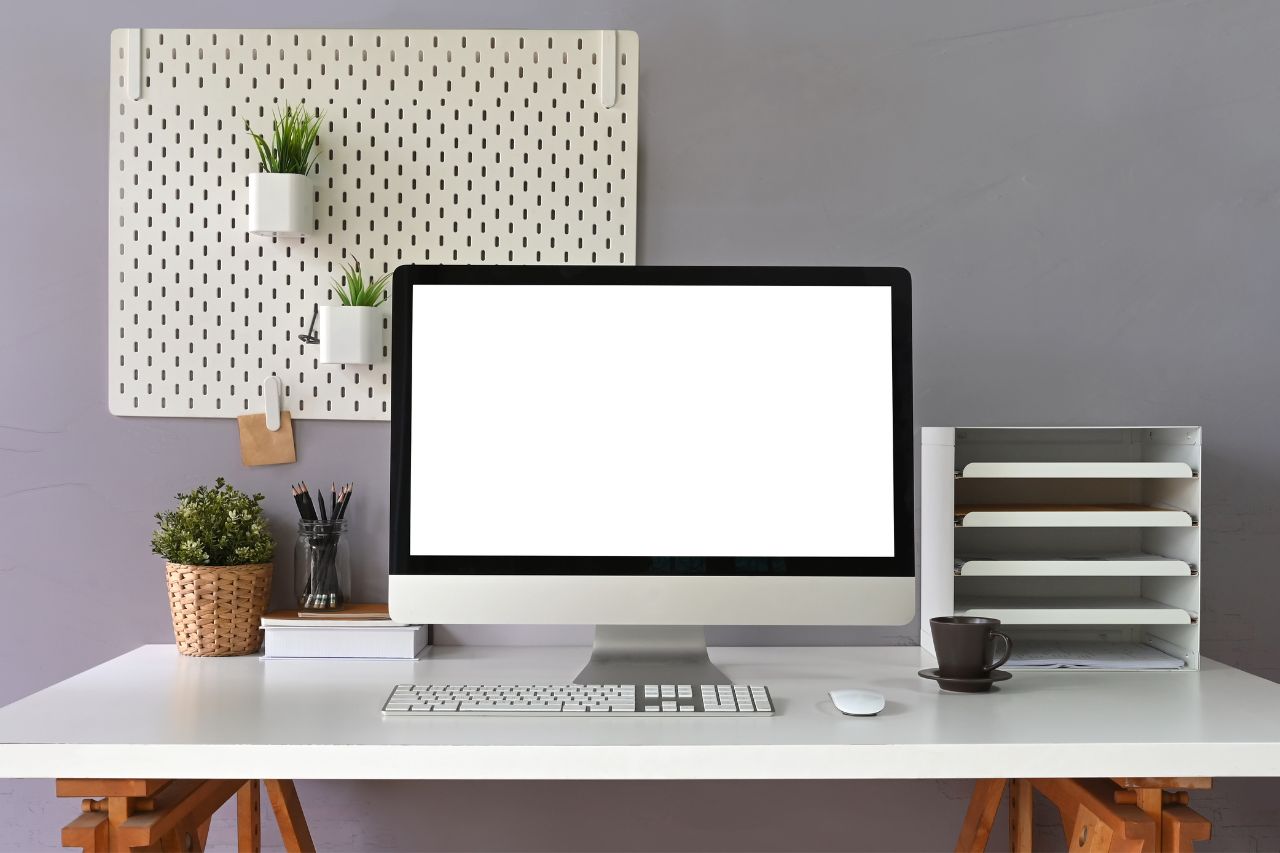
Working with display screen equipment (DSE) is now such an integral part of our lives that we take it for granted. Technology is continually evolving and becoming increasingly embedded in everything we do.
We can easily check our emails, attend meetings, access important documents, browse websites and create content like reports or white papers regardless of our location. It’s the portability of smartphones, tablets and laptops and the range of equipment available to us that’s part of the appeal.
But it’s easy to forget, as you’re typing on the settee, or watching a webinar parked up at a service station on the M4, that the environment you’re working in is not good for you in the long term.
We’re starting to notice that remote workers are living more sedentary lives than those who go out to the workplace. Factors such as no commuting time, lack of structured breaks and not moving from a chair to talk to people are just some of the reasons.
With remote and hybrid working now widely accepted as the norm, we look at the health implications for employees and discuss what organisations can do to control the risks associated with display screen equipment.
What are the health risks of working with display screen equipment?
Musculoskeletal disorders
Musculoskeletal disorders (MSDs) are a set of conditions that affect the muscles, bones, joints, tendons, ligaments, and other supporting structures of the body. MSDs are an increasing problem for remote workers.
Contributing factors are:
- Maintaining the same posture for extended periods of time. For example, sitting or standing in one position without breaks or proper ergonomics.
- Tasks that involve repetitive movements without rest or variation. For example, typing or using a mouse.
- Activities that require forceful exertion or high levels of pressure on parts of the body like the hands, wrists or fingers. For example, using scissors, pencil sharpeners or pliers for a long time without a break.
- Insufficient time allowed for recovery. If the workplace doesn’t allow enough time to recover between tasks this can contribute to MSDs.
A 2017 report[1] showed that one in eight of the working-age population suffered from an MSD, with 36% stating that the condition was related to work.
HSE statistics reveal that in 2021/2022 there were 477,000 employees in Great Britain with new or chronic MSDs. As a result, approximately 7.3 million working days were lost, costing the economy billions.
MSDs affecting the back (42%) and neck & upper limbs (37%) are the most prevalent. Out of the 477,000 MSD sufferers, 72,000 said they thought their condition had been brought on or exacerbated by the pandemic. Factors such as suboptimal home office setups, prolonged sitting, increased screen time, and limited access to ergonomic resources and support systems may play a role.
Using DSE incorrectly can be a contributor to MSDs, particularly back, neck and repetitive strain injury (RSI) complaints. With more people working with display screen equipment remotely, the potential for incorrect use, whether that’s due to posture, screen glare or bad positioning is now much greater.
Becoming less active
Working from an office or another collaborative working environment means that employees need to make the journey to and from work. They may also move around more during the day, from desk to meeting room, or to the cafeteria, or even a lunchtime trip into town.
While working remotely, and particularly if working from home, an employee is likely to be less physically active. This became a trend during the lockdown, when understandably, a lot of common exercises were no longer available. A study[2] showed that 60% of people were not exercising as much during the lockdown, whilst another[3] showed that daily mean steps reduced significantly too, by 5.5% after 10 days, and by 27.3% by day 30.
This is a problem if it becomes a pattern, which for many it has. The World Health Organisation[4] demonstrated that physical inactivity has major implications for the worldwide population, particularly when it comes to noncommunicable diseases (NCD) such as cardiovascular disease, diabetes and cancer.
The WHO estimated that physical inactivity is the principal cause for approximately:
- 21% – 25% of breast cancer and colon cancer
- 27% of diabetes
- 30% of ischemic heart disease.
It also published guidelines in 2020 on physical activity and sedentary behaviour to support the population’s physical and mental health.
The guidelines contained achievable fitness targets, focusing on muscle-strengthening exercises and aerobic activities. The benefits for cardiovascular health, weight maintenance, bone health, cognitive function, and overall physical and mental wellbeing were highlighted.
However, detailedstudies[5][6] of surveys carried out between 2001 and 2020 revealed that 81% of adolescents and 27.2% of adults weren’t meeting aerobic targets. In addition, 80% of adults were not doing enough muscle-strengthening exercises.
The statistics indicate that as a society, we have not made sufficient progress in achieving the physical activity levels necessary to protect our health.

How can organisations minimise DSE health risks?
DSE assessments
So, what steps can organisations take to minimise health risks associated with working with display screen equipment remotely?
We’ll begin with DSE assessments.
Most health risks associated with DSE come from either a poor set up, or from using equipment incorrectly.
Both situations can be corrected with an assessment and then a follow-up to position equipment correctly, provide equipment that’s better suited to the space and ensure that the employee knows how to use the equipment. This includes everything from moving a mouse closer to the user, or providing an eye-level monitor, to better lighting and ventilation.
But away from the workplace, carrying out an assessment, let alone acting on the results, can be much harder.
Understanding the home-working environment
The first thing we can do is learn about the remote-working set up that individuals have at home.
Leesman is a company that specialises in surveys which measure the employee workplace experience. With the shift to more widespread remote working during and following the pandemic, they focused on the home-working experience in 2020.
Their survey revealed that only 37% of respondents had a dedicated office or room, 33% had a dedicated workspace (but not in a separate room), and 27% had a non-specific home location (i.e. a dining room table).
It’s interesting to note that the delineation of the spaces also revealed a very clear separation between age groups. The group with a dedicated office or room tended to be the older group (above 55), whilst those with a non-specific home location tended to be in the youngest group (below 25).
So those people with the highest number of working years ahead of them are potentially working in the conditions most likely to cause MSD issues.
These results show us how difficult it can be to set up a correct workstation at home. Only a third of employees have a dedicated space where time and effort can be invested into basic actions like ensuring the desk/table and chair provide support to promote good posture and are at the right height.
DSE self-assessments
It is a legal requirement to comply with the Display Screen Equipment Regulations (1992). However, it’s important to highlight that they were written over three decades ago. The equipment and our working lives have changed significantly since then. So, it’s vital that organisations go beyond legal requirements to protect the health and wellbeing of employees.
Incorporating additional health and wellbeing elements into DSE assessments, especially in online self-assessments carried out by employees who work remotely, can help address the specific needs and challenges of our post-pandemic world.
Employees can provide information on their home workspace, but also watch videos/animations showing what equipment they need and how to set it up correctly. See our Display Screen Equipment training course which contains step-by-step instructions on setting up a workstation.
Many organisations are going further by ensuring employees can access wellbeing courses and tools (including stress management) and answer more health and wellbeing focused questions.
BT’s online DSE self-assessment system asks employees to indicate how strongly they agree or disagree with a range of statements. These statements are designed to highlight issues which may need to be addressed in a more focused way in future:
“My home environment enables me to work proactively.”
“When I work from home, I am able to maintain a healthy work-life balance.”
“When I work from home, I feel connected to my colleagues.”
Innovating and tackling misinformation
Wellbeing tools for employees can include a range of health-focused resources, with a particular focus on musculoskeletal (MSK) health where a collaborative approach and early intervention are key to tackling the problem.
One option is to integrate an easily accessible mHealth system, using mobile devices to gather information to diagnose and treat health conditions.
Millions of people use Google and other search engines when they’re looking for advice on medical issues, including MSDs. Unfortunately, the internet is flooded with vast amounts of information, and we know it’s not all accurate or trustworthy.
A recent study by the Chartered Institute of Physiotherapy uncovered the extent of this problem when a team of specialist musculoskeletal physiotherapists studied the 100 most viewed videos on YouTube when searching for ‘advice and treatment for back pain’.
Some of the videos had millions of views, but the specialists found that nearly half (43%) contained a myth, 60% contained false or misleading information, almost a third (32%) featured an unrealistic video demo and nearly half (45%) didn’t state any qualifications for providing advice.
Some organisations are addressing the issue of misinformation by signposting employees to accurate, professional medical advice and wellbeing resources within their own hubs. By using centralised platforms, employees can make informed decisions about their health and wellbeing.
Work-life balance
It can be difficult to switch off when working from home. When employees work on their laptops at the kitchen table, life and work begin to blur.
If workload becomes overwhelming, and people start to feel isolated from others at work it can lead to stress, anxiety and depression.
In 2007, the HSE conducted a large-scale 12-month survey of 1,327 DSE users in organisations of different sizes across the UK. This pre-pandemic study looked at potential mental ill health faced by DSE users and discovered that:
- Anxiety, depression and stress were more common in younger respondents.
- All three were more common in those who worked more than five hours over their contracted hours.
- Distress was more common in those working more than one hour without a break.
- Anxiety and depression were more common in those spending longer per week working with display screen equipment.
Working remotely, spending extended periods of time in front of a screen, and being constantly contactable has increased people’s risk of developing mental health conditions.
Travelling to and from a workplace creates natural separation between work and home life. Plus, commuting home from work can be a time to decompress and process the day’s events.
To address this, remote workers could be encouraged to go for a walk before and after work to separate home and work life. Some people might choose to go swimming, visit the gym, or even engage in ‘commuter’ activities like reading a book or listening to music.
It’s essential to establish a balance between work and home life.
Healthy work habits
Without the structure and natural cues provided by the office environment, it can be easy for remote workers to fall into the trap of being constantly connected and neglecting breaks.
At home, for example, there may be nobody else to stop and talk to so there’s no incentive to take a break. This means people are sitting down for hours at a time without standing up or changing position.
Here are some ways to address the issue:
- Encourage regular breaks from screens through reminders, or even implementing break tracking apps.
- Designating ‘standing’ meetings. People could be encouraged to participate in a meeting while standing or even going for a walk.
- Schedule meetings that are 10 minutes shorter and encourage people to use the time saved to take a break.
- Introduce standing desks and encourage employees to use them.
Here are some more tips for healthy remote working you could share with your employees.

How can organisations ensure employees working remotely follow best practices?
Evidence is key
As we have seen with the WHO guidelines on physical inactivity, it’s one thing to know what one should be doing, but quite another to commit to it. This is clearly true when it comes to exercise and staying active, but it’s also true when it comes to working with display screen equipment.
Employees may have access to the right equipment and set up, but how can employers ensure they are working at a desk set at the right height for the monitor and chair, that the mouse is not too far away, and that there is adequate lighting?
The simple answer is that they can’t.
What employers can do, however, is to encourage employees to make healthy decisions by using evidence to back up advice. This article contains plenty of evidence to support the case for correct DSE use and the importance of physical activity. Whilst it shouldn’t be used to frighten people, it can be used to encourage good practices.
It’s more effective to take a supportive, advisory approach than an approach based on fear.
For example, you could communicate the message:
“Setting your screen at the same height as your eyes, and ensuring your mouse is close to your keyboard can help you to avoid long-term neck and arm pain, something suffered by over 176,000 people in Great Britain.”
Rather than:
“Set up your screen, mouse and keyboard correctly, or you’ll become one of the 176,000 people in Great Britain with long-term neck and arm pain.”
It’s also worth noting that we can’t expect people to change habits overnight. Small changes, whether we’re talking about using DSE correctly or becoming more active, are better than no changes. Slow progress is still progress.
Is working remotely suitable for everybody?
As an employer, you want your employees to be able to work safely, and not put themselves in danger of developing a physical or mental condition due to the way they’re working.
A lot depends on trust. Are your employees completing their DSE self-assessments honestly? Should you ask for evidence showing their workspace? And if the workspace is inadequate, do you need evidence of action taken to improve the situation?
The answers depend on your organisation. The bottom line, however, is that if as an employer, you believe an employee is putting themselves at risk of long-term harm, it’s your responsibility to step in.
Unfortunately, that may mean that some people are unsuitable for remote working because they can’t provide evidence of a suitable workspace.
Final thoughts
The way ahead is to consider remote working and safe use of display screen equipment as part of a broader wellbeing and health framework.
Whether you’re a large organisation with the resources to create an online hub for employees, or a small business, using face-to-face sessions and emails to communicate messages, gathering relevant information and providing well-signposted training and ongoing support are essential.
Fostering a culture of open communication is the key to supporting employees’ physical and mental health.
If employees feel comfortable to say when they’re suffering from aches and pains, then steps can be taken to help them. Most of the MSDs we discussed here take many years to become chronic conditions.
With regards to mental health, we are now as a society becoming more willing to share our experiences and struggles, which benefits everyone.
To explore the topics discussed here in more detail, please watch our webinar, Ergonomics and the agile workplace wellbeing agenda.

Adam Clarke
Managing Director (Consulting)
[1] Business in the community, Musculoskeletal health in the workplace: a guide for employers, 2017
[2] Bevan et al, 2020: IES working at home wellbeing survey
[3] Tilson et al, 2020
[4] Global health risks: mortality and burden of disease attributable to selected major risks, Geneva, WHO, 2009
[5] Guthold R, Stevens GA, Riley LM et al. Worldwide trends in insufficient physical activity from 2001 to 2016; a pooled analysis of 358 population-based surveys with 1.9 million participants. Lancet Global Health 2018, 6:e 1077-86
[6] Guthold R, Stevens GA, Riley LM et al. Global trends in insufficient physical activity among adolescents; a pooled analysis of 298 population-based surveys with 1.6 million participants. Lancet Child Adolescent Health 2020, 4: 23-25
